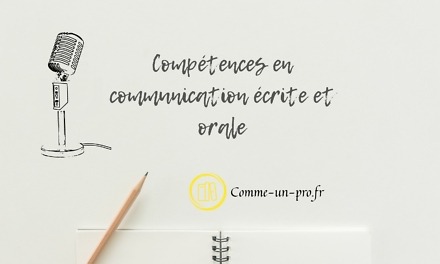Write to be read
A colleague just emailed you about a meeting you have in an hour. The email is supposed to contain the key information that you need to present, as part of an important project.
But there's a problem: the email is so badly written that you can't find the data you need. There are spelling mistakes and incomplete sentences. The paragraphs are so long and confusing that it takes you three times as long as it takes to find the information you want. As a result, you're underprepared for the meeting and it doesn't go as well as you'd hoped.
Have you ever faced a situation similar to this? In a world overloaded with information, it is essential to communicate clearly, concisely and effectively. People don't have time to read book-length emails, and they don't have the patience to interpret emails that are poorly constructed and where useful information is scattered all over the place.
Plus your writing skills are good, the better the impression you will make on those around you, including your boss, colleagues and clients. You never know how far these good impressions will take you.
In this article, we'll see how you can improve your writing skills and avoid common mistakes.
Audience and format
The first step to writing clearly is to choose the appropriate format. Do you need to send an informal email? Write a detailed report? Or write a formal letter?
The format, along with your audience, will define your “writing voice,” i.e. how formal or relaxed the tone should be. For example, if you are writing an email to a potential client, should it have the same tone as an email to a friend?
Definitely not.
Start by identifying who will read your message. Is it for senior executives, the whole team, or a small group working on a specific file? In everything you write, your readers, or recipients, need to define your tone as well as aspects of the content.
Composition and style
Once you know what you are writing and for whom you are writing, you must start writing.
A blank, white computer screen is often intimidating. It's easy to get stuck because you don't know how to start. Try these tips for composing and formatting your document:
- Start with your audience: Remember that your readers may know nothing of what you tell them. What should they know first?
- Create a plan: This is particularly useful if you are writing a longer document, such as a report, presentation or speech. Outlines help you identify which steps to follow in which order and break the task down into manageable information.
- Try a little empathy: For example, if you are writing a sales email for potential customers, why should they care about your product or your sales pitch? What is the benefit for them? Remember the needs of your audience at all times.
- Use the rhetorical triangle: If you're trying to persuade someone to do something, be sure to explain why people should listen to you, get your point across in a way that will engage your audience, and present the information in a rational and coherent way.
- Identify your main theme: If you have difficulty defining the main theme of your message, pretend that you have 15 seconds left to explain your position. What do you say ? This is probably your main theme.
- Use plain language: Unless you're writing a scientific paper, it's usually best to use simple, straightforward language. Don't use long words just to impress people.
Structure
Your document should be as user friendly as possible. Use titles, subtitles, bullets and numbers as much as possible to separate the text.
After all, what could be easier to read: a page filled with long paragraphs or a page broken up into short paragraphs with section headings and bullet points? A document that is easy to scan will be read more often than a document with long, dense paragraphs.
Headings should grab the reader's attention. Using questions is often a good idea, especially in ad copy, because questions help keep the reader interested and curious.
In e-mails and proposals, use short, factual titles and subtitles, such as those in this article.
Adding graphics is also a smart way to separate your text. These visual aids not only allow the reader to keep his attention on the content, but also to communicate important information much faster than the text.
Grammatical errors
You probably know that mistakes in your email will make your work look unprofessional. It is essential to avoid gross mistakes by getting yourself a spell checker and revising your spelling as much as possible.
Here are some examples of commonly used words:
- I send / send / send you
The verb "to send" being a verb of the first group, one will always write in the first person of the singular "I send" with an "e". "Shipment" without "e" is a name ("a shipment") and may be plural: "shipments".
- I join you / I join you
One will always write "I join you" with an "s". "Joint" with a "t" is the conjugation of the third person singular "he joins".
- Deadline / deadline
Even if "bumper" is affixed to a feminine name, do not give in to temptation and always write "bumper" without "e".
- Recommendation / recommendation
If in English we write "recommendation" with an "e", in French we always write "recommendation" with an "a".
- Is there / is there / is there
We add a euphonic “t” in interrogative formulas to facilitate pronunciation and prevent two vowels in succession. We will therefore write "is there".
- In terms of / in terms of
One never writes "in terms of" without an "s". There are indeed always several "terms" in the use of this expression.
- Of / among
Be careful not to be misled by the word "except" which ends with an "s". One never writes "among" with an "s". It is a preposition and it is invariable.
- As agreed / as agreed
Even affixed to a feminine name, "as agreed" is always invariable and never takes an "e".
- Maintenance / service
Do not confuse the name and the verb. The name "interview" without "t" describes an exchange or a "job interview". The conjugated verb in the third person of the singular "maintains" is used when it comes to doing the action of maintaining something.
Some of your readers will not be perfect in spelling and grammar. They may not notice if you make these mistakes. But do not use this as an excuse: there will usually be people, especially senior executives, who will notice!
For this reason, anything you write should be of an acceptable quality for all readers.
Verification
The enemy of a good proofreading is speed. Many people rush through their emails, but that's how you miss errors. Follow these instructions to verify what you wrote:
- Check your headers and footers: People often ignore them to focus only on the text. Just because the headers are big and bold doesn't mean they're error-free!
- Read the email aloud: This forces you to go slower, which means that you are more likely to detect errors.
- Use your finger to follow the text as you read: It's another thing that helps you slow down.
- Start at the end of your text: Re-read a sentence from the end to the beginning, it helps you focus on the errors and not the content.




